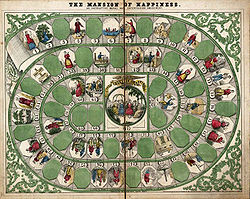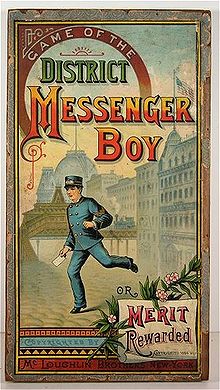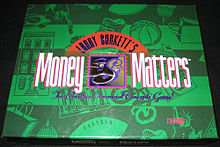- The Mansion of Happiness
-
The Mansion of Happiness: An Instructive Moral and Entertaining Amusement is a children's board game inspired by Christian morality. Players race about a sixty-six space spiral track depicting virtues and vices with their goal being The Mansion of Happiness at track's end. Instructions upon virtue spaces advance players toward the goal while those upon vice spaces send them further away from it.
The game was designed by George Fox in England in 1800 where it was published by Laurie and Whittle. The designer's name is mentioned on the game board as well as the English game board Reward Of Virtue. Design of The Mansion Of Happiness has wrongly been attributed to Anne Abbott[1], who designed the famous card game Dr. Busby in 1843 (which sold 15,000 copies in 18 months)[2] and the less popular game Master Roddenbury in 1844, published by W. & S.B. Ives of Salem, Massachusetts. W. & S. B. Ives republished the English game, The Mansion of Happiness in 1843, and it was republished by Parker Brothers in 1894 after George S. Parker & Co. bought the rights to the Ives games. The republication claimed The Mansion of Happiness was the first board game published in the United States of America; today, however, the distinction is awarded to Lockwood's Travellers Tour games of 1822. The popularity of The Mansion of Happiness and similar moralistic board games was challenged in the last decades of the 19th century when the focus of games became materialism and competitive capitalistic behavior.
Contents
Context
With the industrialization and urbanization of the United States in the early 19th century, the American middle class experienced an increase in leisure time.[3][4] The home gradually lost its traditional role as the center of economic production and became the locus of leisure activities and education under the supervision of mothers.[3] As a result, the demand increased for children's board games emphasizing literacy and Christian principles, morals, and values.[3] Advances in papermaking and printing technology during the era made the publication of inexpensive board games possible,[3] and the technological invention of chromolithography made colorful board games a welcome addition to the parlor tabletop.[4]
One of the earliest children's board games published in America was The Mansion of Happiness (1843), "the progenitor of American board games".[5] Like other children's games that followed in its wake, The Mansion of Happiness was based on the Puritan world view that Christian virtue and deeds were assurances of happiness and success in life.[4] Even game mechanics were influenced by the Puritan view.[3] A spinner or a top-like teetotum, for instance, was utilized in children's board games rather than dice, which were then associated with Satan and gambling.[3] While the Puritan view forbade game playing on the Sabbath, The Mansion of Happiness and similar games with high moral content would have been permitted children in more liberal households.[6]
In 1860, Milton Bradley developed a radically different concept of success in The Checkered Game of Life, the first American board game rewarding players for worldly ventures such as attending college, being elected to Congress, and getting rich.[4] Virtue became a means to an end rather than an end in itself. Daily life was the focus of the game with secular virtues such as thrift, ambition, and neatness receiving more emphasis than religious virtues.[3] Indeed, the only suggestion of religion in Bradley's game was the marriage altar.[3] The Checkered Game of Life was wildly popular, selling 40,000 copies in its first year.[4]
Protestant America gradually began viewing the accumulation of material goods and the cultivation of wealth as signs of God's blessing,[3] and, with the decade of economic expansion and optimism in the 1880s, wealth became the defining characteristic of American success. Protestant values shifted from virtuous Christian living to values based on materialism and competitive, capitalist behavior. Being a good Christian and a successful capitalist were not incompatible.[3] Dice lost their taint during the period, and replaced teetotums in games.[4]
In a twist on The Mansion of Happiness, McLoughlin Brothers and Parker Brothers released several games in the late 1880s based on the then-popular Algeresque rags to riches theme.[5] Games such as Game of the District Messenger Boy, or Merit Rewarded, Messenger Boy, Game of the Telegraph Boy, and The Office Boy allowed players to emulate the successful capitalist.[3] Players began these games as company underlings, newbies, or gofers, and, with luck, won the game with a seat in the President's Office (rather than a seat in Heaven, as in The Mansion of Happiness) or as Head of the Firm.[4] In Parker Brothers' The Office Boy, spaces designated carelessness, inattentiveness, and dishonesty sent the player back on the track while spaces designated capability, earnestness, and honesty advanced him toward the goal.[5] Such games reflected the belief that the enterprising American - regardless of his background, humble or privileged - would be rewarded under the American capitalist system,[4] and insinuated that success was equated with increased social status via the accumulation of wealth.[3]
Wealth and goods became game rewards during the last decades of the 19th century with the winner of McLoughlin Brothers' The Game of Playing Department Store, for instance, being the player who carefully spent his money accumulating the most goods in a department store.[4] Bulls and Bears: The Great Wall St. Game promised players they would feel like "speculators, bankers, and brokers",[4] and the 1885 catalog advertisement for McLoughlin Brothers Monopolist informed the interested, "On this board the great struggle between Capital and Labor can be fought out to the satisfaction of all parties, and, if the players are successful, they can break the Monopolist and become Monopolists themselves".[4]
Game play
The game board's goal at track's end depicts men and women making music and dancing before a house and garden.
The Mansion of Happiness is a roll-and-move track board game, and, typical of such games, the object is to be the first player to reach the goal at the end of the board's track, here called The Mansion of Happiness (Heaven).[3] Centrally located on the board, the goal pictures happy men and women making music and dancing before a house and garden.[6] To reach The Mansion of Happiness, the player spins a teetotum and races around a sixty-six space spiral track depicting various virtues and vices.[3]
Instructions upon spaces depicting virtues move the player closer to The Mansion of Happiness while spaces depicting vices send the player back to the pillory, the House of Correction, or prison, and thus, further from The Mansion of Happiness.[6] Sabbath-breakers are sent to the whipping post.[6] The vice of Pride sends a player back to Humility, and the vice of Idleness to Poverty.[7] The game's rules noted:
"WHOEVER possesses PIETY, HONESTY, TEMPERANCE, GRATITUDE, PRUDENCE, TRUTH, CHASTITY, SINCERITY...is entitled to Advance six numbers toward the Mansion of Happiness. WHOEVER gets into a PASSION must be taken to the water and have a ducking to cool him... WHOEVER posses[ses] AUDACITY, CRUELTY, IMMODESTY, or INGRATITUDE, must return to his former situation till his turn comes to spin again, and not even think of HAPPINESS, much less partake of it."[3]
Design and publication
The Mansion of Happiness was not designed but may have been slightly reworked from the original 1800 English game in 1843 by Anne Wales Abbott (1808–1908), the daughter of a Beverly, Massachusetts clergyman.[8] Abbott was the author of moralistic fiction for children including Lost Wheelbarrow and Other Stories, and Kate and Lizzie, or Six Months Out of School. She was literary reviewer for the North American Review (she reviewed Hawthorne's The Scarlet Letter),[9] and served gratuitously as editor of The Child's Friend, a young people's literary journal whose mission it was "to cultivate a pure and high moral taste".[10] More importantly, she designed popular card games, Master Roddenbury in 1844 and more important: Dr. Busby, first published in March 1843[11] according to advertisements in the Salem newspapers. Dr. Busby caused the popularity of games in America to explode the same way Monopoly did just after the depression. Remember, slaves and the working poor could not afford the $.50 price of the game which was listed in both the Salem Gazette and Salem Observer in Christmas 1843.[12] Since in 1843 there were less than 2.5 million people in the United Stales and from this we must deduct slaves, working poor, and hand-to-mouth farmers. the United States sale of 50,000 games in less than two years is about the same percentage of buyers to population as Monopoly had when first published in the 1900's. Dr. Busby's sales helped propel sales of Ives' The Mansion of Happiness to 5000 in two years. The image of the game posted at the top of the article is the third printing as denoted by its lithographer Chandler. The first two printings were handled by Thayer & co. out of Boston who were out of business by 1847. The original Laurie & Whittle game was printed using a gold colored ink and octagonal center space and Ives attempted to duplicate this in the first Thayer print run. In the second Thayer print run, circa 1844, the main color of the board was changed to green but the center space was still octagonal. Like most American games of the middle 19th century, The Mansion of Happiness was almost an exact duplicate of the imported English model with its direct prototype being the New Moral and Entertaining Game of The Mansion of Happiness published in 1800 by Laurie and Whittle of London. Laurie and Whittle's game was, in its turn, similar to, but not exactly the same as the Italian The Game of the Goose, registered in Stationer's Hall in London in 1597.[13]
The Mansion of Happiness was published the year of its redesign by W. & S.B. Ives of Salem, Massachusetts.[3] When the last of the Ives brothers died in 1888, board game titans Charles and George Parker purchased the rights to The Mansion of Happiness. In 1894, Parker Brothers republished The Mansion of Happiness as closely as possible to the game's original format with board illustrations hand-colored by an assembly line of women wielding paint pots and brushes. The game remained in the Parker Brothers catalog for thirty years, displaying the line, "The first board game ever published in America" on its box cover.[5][14] The distinction of "the first" however is awarded today to Traveller's Tour of the United States and Traveller's Tour of Europe published by New York book sellers F. & R. Lockwood in 1822.[15][16]
Legacy
In spite of America's fascination with wealth and goods in the last decades of the 19th century, didactic Christian games held sway then and well into the twentieth. Even as late as 1893, for example, McLoughlin Brothers released The New Pilgrim's Progress, an upgrade of its 1875 publication based on John Bunyan's moralistic Christian classic, The Pilgrim's Progress. Similar to its predecessor, the new edition of the game saw players racing about a track from the City of Destruction to The Celestial City with way-stops at The Slough of Despair, Vanity Fair, and Beulah Land.[4]
The affluence of the last decades of the 19th century generated America's first board games based on the idea that happiness and success were not incompatible with the accumulation of wealth through competitive, capitalistic behavior and culminated in 1935 with the publication of Monopoly, the most commercially successful board game in United States history.[17]
Games with a Christian moral cast still hold a place on the American tabletop. Rainfall Educational Toys' Larry Burkett's Money Matters: The Christian Financial Concepts Game (1993) has players of seven years to adulthood moving about a board collecting income and paying off bills. The game's rule book states:
"Stewardship means taking care of our possessions, knowing that everything we have actually belongs to God. A key goal of this game is to teach that it is not how much money people have but their stewardship that is important. Players learn that (1) they can reach their financial goals by budgeting their money carefully and (2) it pays to be generous".[18]
References
- ^ Angiolillo, Joseph A. Jr. "The Quest to Find The First American Board Game: Game Times" Volume VII #2 Issue #15 August 1991, 4628 Barlow Drive, Bartlesville, OK 74006, p 313.
- ^ Abbott, Anne Wales. "Doctor Busby and His Neighbors" 1844 W. & S.B. Ives, Stearns's Building, p ii.
- ^ a b c d e f g h i j k l m n o p Jensen, Jennifer. "Teaching Success Through Play: American Board And Table Games, 1840–1900". Magazine Antiques, December, 2001.
- ^ a b c d e f g h i j k l Hofer, Margaret K.. The Games We Played: the Golden Age of Board & Table Games. Princeton Architectural Press, 2003. ISBN 1568983972.
- ^ a b c d Orbanes, Philip E.. The Game Makers: The Story of Parker Brothers, from Tiddledy Winks to Trivial Pursuit. Harvard Business School Press, 14 November 2003. ISBN 1591392691; ISBN 978-1591392699.
- ^ a b c d Volo, James M., and Dorothy Denneen Volo. Family Life in 19th-century America. Greenwood Publishing Group, 2007. ISBN 0313337926 / ISBN 9780313337925.
- ^ The Journal of American Folk-Lore. Vol. VII, No. XXIV, January–March, 1894.
- ^ Wolverton, Nan. "Toys and Childhood in the Early 19th Century". Old Sturbridge Village Visitor. Spring, 1998.
- ^ Crowley, Donald. Nathaniel Hawthorne: The Critical Heritage. Routledge, 1997. ISBN 041515930X / ISBN 978-0415159302.
- ^ Pflieger, Pat. American children's periodicals, 1841-1860. 2006-2008. Retrieved 11 November 2008.
- ^ Salem Gazette. 1843.03.07 page 2 column 1.
- ^ Salem Observer. 1843.11.25 page 3 column 5.
- ^ "Laurie and Whittle's New Moral and Entertaining Game of The Mansion of Happiness." Scran ID: 000-000-629-669-C. Victoria & Albert Museum. Retrieved 11 November 2008.
- ^ Whitehill, Bruce. "A Brief History of American Games". Toy Shop, 1997.
- ^ Van Dulken, Stephen. American Inventions: A History of Curious, Extraordinary, and Just Plain Useful Patents. NYU Press, 2004. ISBN 0814788130 / ISBN 978-0814788134.
- ^ Rickards, Maurice, Twyman, Michael, De Beaumont, Sally, and Tanner, Amoret. The Encyclopedia of Ephemera: A Guide to the Fragmentary Documents of Everyday Life for the Collector, Curator, and Historian. Routledge, 2000. ISBN 0415926483 / ISBN 978-0415926485.
- ^ History of the Game Monopoly. Retrieved 24 November 2008.
- ^ Larry Burkett's Money Matters at Game Board Geek. Retrieved 20 December 2008.
Categories:- Children's board games
- History of board games
- Parker Brothers games
- Race games
- Roll-and-move board games
- Tabletop games
Wikimedia Foundation. 2010.




